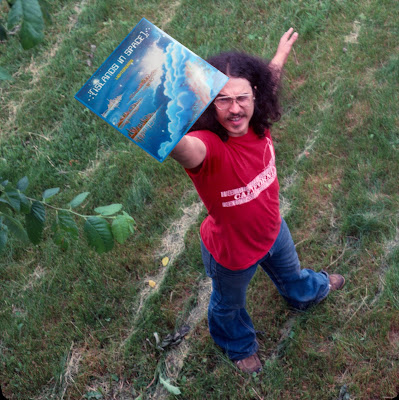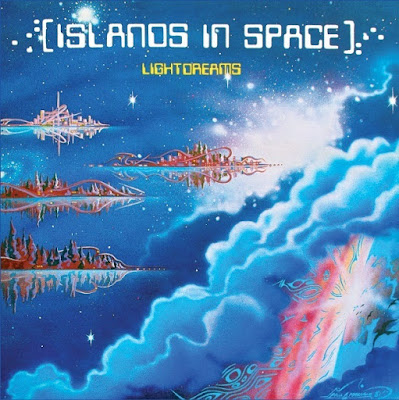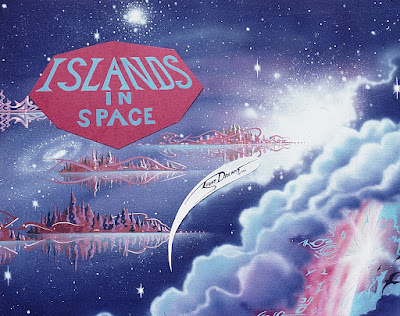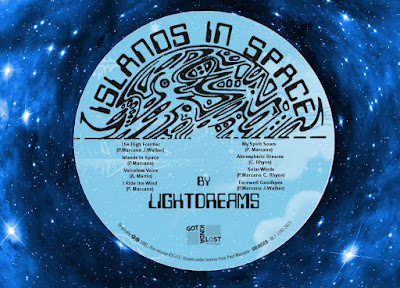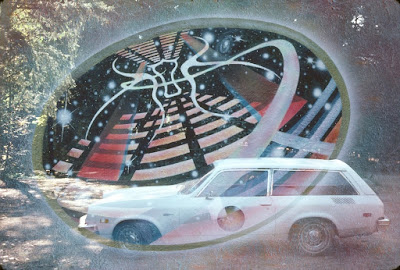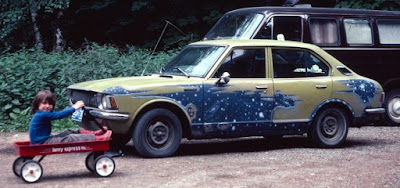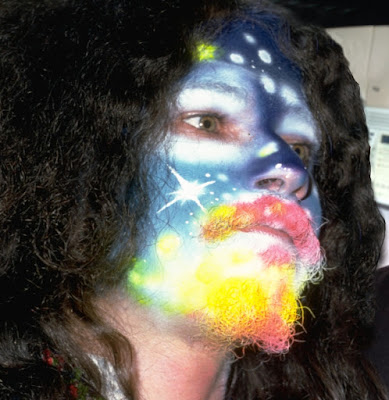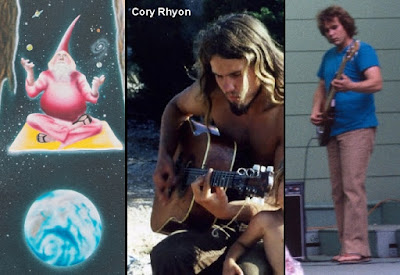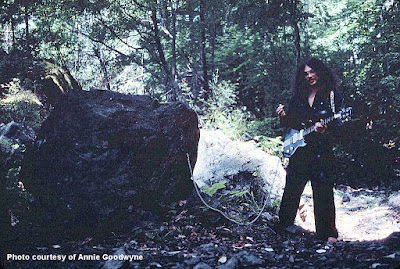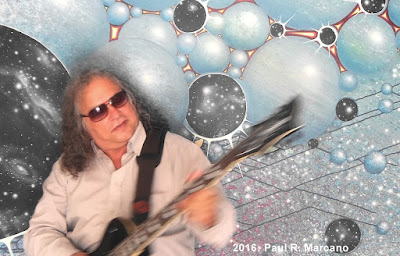LightDreams interview with Paul R. Marcano
I grew up in Pound Ridge, New York, and moved to the Ottawa valley in Canada when my mother remarried around 1960.
My mother played classical music almost exclusively while working as an artist and so I always had an ear for music and enjoyed learning to sing in school choirs too. One day my mother brought home a couple of singles by the Beatles. Those songs completely altered my appreciation for music and it was not long before I acquired a guitar. A few early formal guitar lessons almost killed my interest, as I was clearly more adept at playing by ear than struggling with reading notes off a sheet of paper. Later as a teenager I began to realize that the energy it takes to learn someone else’s song is roughly equivalent to the energy it takes to come up with something uniquely your own, with a bonus that you are creating something new to share.
Islands In Space was my 12th album of original music following almost a decade of recordings using the reel-to-reel, sound on sound technology of a Sony TC-630. I did play in a cover band for a while in the mid-’70s and also performed my own songs with a loose association of other musicians, but my love for studio recording and production was greater. Islands In Space was only my second stereo album after an album I made called Silent Circuits. Both utilized the groundbreaking TEAC 144 multi-track recorder, which revolutionized home recording in the early 1980s. With care and attention it was possible to create some very reasonable results from that early technology. When I finally released a vinyl pressing of Islands In Space in 1981, the TEAC Corporation in Japan actually sent a couple of executives over to purchase a couple of cases of LightDreams’ first album. I was thrilled and years later found that the album had entered the underground music scene in Japan where it was categorized as “Psychedelic Electronic Folk Music”. Used copies were selling for rather higher prices than I could ever have imagined.
I was coming out of having listened to the progressive rock efforts of bands like Gentle Giant, Pink Floyd, Caravan, Alan Parsons, King Crimson (and their former members’ McDonald and Giles album). Progressive rock pretty much saturated the panorama of my listening throughout the ‘70s. I feel as if Alan Parsons taught me most about production values and mixing, while David Gilmour was my guitar teacher and McDonald and Giles were the gurus of lengthier song construction with an imaginative flair. It was as much about the technical aspects of progressive rock as it was about the music itself that influenced me. It is true that Psychedelics were waning in interest by the ‘80s (something about potential jail time takes the luster off of such things) but I found Psychedelics far more of a catalyst for creativity than my seeking another altered state. For me, it inspired my imagination and was an excellent way to acid test new songs and determine if they were really any good, everything tends to be perceived so incredibly fresh and new. Often after hours of working on a song, an artist has a hard time critiquing or listening to it objectively. Almost any altered state can allow you to ‘hear it again for the first time’ but I think psychedelics are remarkable in the way your mind opens up to an uncanny free association around a single perception of something. A song can simultaneously take on meaningful dimensions musically, structurally, emotionally and often as not, a spiritual significance you might not have previously realized.
The concept was always meant to be multi-fold. Side one focuses on the visionary ideas of Gerard O’Neill’s concept for space colonies as illustrated in his book The High Frontier. He could see the advantages of space habitats and the notion that space exploration challenges the frontiers of the unknown. I was most intrigued with the underlying message that grand human endeavours involving international involvement and cooperation have the potential for unifying nations. What made space habitats such an intriguing theme for an album was the parallels I was seeing between the material adventure of outer space travel and the spiritual adventure of inner space mind expansion. On a purely practical level, with all our eggs in one basket it seems prudent that we expand our presence off-world ‘just in case’ and I wanted to share that idea with people. I am not a pessimist but there is a fragility to our existence given our exposure to random asteroids coming our way, geological changes or even major solar events.
Side two of the album explores an inner space journey that for most of us is far more economical and accessible through mind expansion, meditation and exploring the depth of our being. In many ways one could say that space travel is kind of taking the long way home to a realization that we are citizens of an already existing ‘island in space,’ one we call the the blue planet. This is, after all, our first journey through Galactic time and space, moving at approximately a million miles an hour, so who knows where the Earth will be tomorrow? Islands In Space illustrates musically the adventure of space travel and mind expansion.
Would you share your insight on the album’s tracks?
“The High Frontier”
This melodic piece bookends the album and offers an auditory launch pad for what is to follow. John Walker’s warped guitar playing sets the stage for an improvisational composition that I had a lot of fun working on, using everything from backwards guitar inter-play to a launch sound effect derived by stuffing newspaper up a chimney and lighting it to burn off the soot buildup. I wanted to intro the album with a tribute to Gerard O’Neill’s book The High Frontier, which for me was a life changing moment realizing technology’s full potential as I was coming out of a ‘70s ‘back to the land’ movement. Building space habitats may seem impossibly challenging, yet trillions of dollars are squandered not building anything at all, just destroying infrastructure and peoples’ lives. The high frontier lifts our gaze to the stars and beyond.
“Islands In Space”
Well this, of course, is the title cut and people may notice it fades in. The fact is, it is part two of a longer song I had to truncate in order to make room for Andre Martin’s “Voiceless Voice,” which blew my mind when Andre handed it to me on a small tape reel. Unfortunately, vinyl records offer limited time per side and I needed to make a difficult choice to shorten “Islands In Space” to fit. It is really the only cut on the album where a full compliment of musicians appear. LightDreams was always basically made up of the three main writers: Andre Martin, Cory Rhyon and myself. Though, on “Islands In Space” we also had studio musicians Art Lowe playing bass and Tim Moore contributing a very sweet saxophone part. The lyrics are a poetic description of our origins and continuing drive to return, like salmon, as I sing “it was out of the stardust we were born to return… from this cradle… of our civilization.”
“Voiceless Voice”
When Andre presented this piece to me he had no idea what I was working on, yet it was so right for the project that I basically had to realign the entire album to accommodate his 7 minute sojourn into inner and outer space. I think he was like 19 years old at the time and had just bought a synthesizer. I did not want to add anything to it, just bookend it with some space shuttle and ground control chatter to set the atmosphere for this beautiful symphonic space journey. As was often the case in the years to come, Andre would contribute compositions like this that would alter projects I was working on. Sadly, he contracted cancer and died earlier this year at the young age of 54, but thankfully he lived long enough to see the reissue of the album and his excellent contribution spread to more listeners. He is sorely missed as we ended up creating a lot of music together over the years.
“I Ride the Wind”
Islands In Space includes a couple of earlier compositions I wrote in the ‘70s that just happened to work well on this concept album. “I Ride the Wind” serves as a transition piece that takes us over to side two. It utilizes a twelve-string guitar and is reflective of my acoustic guitar songwriting style. The song was written outdoors where I often soak up inspiration from contact with the natural elements, whether under open skies or deep in the forest. The lyrics in this song express how we ‘become the day’ and how we have a fleeting relationship with each thought that wells up in us like a wave, which peaks and crests in a frenzy of intrigue only to subside as our stream of consciousness brings on yet another thought that passes on through us as we “ride with the wind.”
“Atmospheric Dreams”
Side two opens with two pieces of music that Cory Rhyon and I melded. Starting with “My Spirit Soars,” where I make an effort lyrically to illustrate why “I feel ok” and that “I wouldn’t miss this trip for the world today.” It is for me the equivalent of an inner launch pad and although it is psychedelically inspired, I like that it ends by recognizing that “everybody seems to like to find their own way home.” In matters of spirit I think so much nuance is made of our differences, when in fact it is not a political issue at all but rather a respect for an individual’s taste and choices. I think it is best to acknowledge how truly amazing one’s individual experience of the Universe can be from your unique perspective and then share it with others. The song merges delicately into Cory Rhyon’s main contribution, “Atmospheric Dreams,” an incredibly lucid and spontaneously composed acoustic guitar journey. Cory was always the earthbound one who understood he was part of a cosmology and when he played you could feel his high frontier perspective, yet with feet firmly on the ground. Sadly, Cory also passed away from cancer a couple of years ago, but he left a huge body of work that can be accessed off our website at www.lightdreams.info. I have dedicated a page to both Andre and Cory featuring their independent work created outside their time with LightDreams.
“Solar Winds”
Cory loved my song “I Ride the Wind,” and here you may recognize that he’s playing the chords in his own illuminating way, while I create a background soundscape of solar winds and cosmic noises meant to punctuate the dangerous radiation in the extreme conditions of space. At the time of this recording I think we played the piece out to almost 20 minutes, from which I selected only a portion to include on the album. Aside from a very primitive (by today’s standards) little synthesizer we rented, I layered other sounds, among them actual radio telescope sounds of solar winds that National Geographic had included as a flexi-disc in one of their issues. The track blending I did makes for a uniquely synthesized soundscape that rivals some of the more sophisticated sounds possible at the push of a button with newer synth technology. Yeah, love buttons!
“Farewell Goodbyes”
This is a final reprise mirroring the first song “The High Frontier” and adds in what I think of as a little futuristic bedtime story, something they might play from an actual space habitat someday. It has a retrospective feel that consolidates the underlying messages of the album if it has not been made clear all along. I remember Cory and I were listening to the final mix and I just started adlibbing the lyrics you hear. It was amazing how the lines just flowed out while listening to the music. I wrote them down pretty much as is and later refined how I would speak and sing them. I think it is a fitting concluding piece that encapsulates the concept of what Islands In Space is all about.
I mentioned a lot about the writing above, but my process is generally to play a guitar or a keyboard until something happens that moves into some kind of conceptual continuity. It is as much an act of self-discovery what is next as anything else. However, I have a funny mathematical notion that once 5 notes are played in a melodic sequence, the sixth note is almost a given, and so on with the seventh note, eighth note and onward. The certainty of how a composition comes into being seems increasingly self-evident as you dive deeper into it. I think the key to all creativity is just to get past the procrastination about starting something, anything. Sure, you’ll either sink or swim, but the likelihood is that your creative survival instincts will kick in and you’ll have something accomplished before you even know it! After I have a basic structure of music I then decide if it is sufficient as an instrumental, or whether it has the essence of a song that might include lyrics. If it does, I then cherry-pick a given stream of consciousness inspired by the rhythm or melody within the music and eventually I cull the best lines I write out, often discovering for myself what it is I am attempting to say. Being self-taught, I rely on an active imagination and careful appreciation of the subtlety of inspiration’s fleeting appearance.
It was released in a DIY ethic, 1000 copies?
Yes, a limited edition of 1000 vinyl copies and a few custom cassette tapes that included the original unedited version of Islands In Space on the flip side of a C-90. The album itself was financed by friends, among them a fellow known on the west coast as Mushroom Dann. Dann was the main ‘angel investor’ with no strings attached, he just wanted to see this album out there and I am forever thankful for his encouragement and support. Of course, my wife Cathy has always been there supporting my work right from the start and we’ve been together since we were teenagers! As an early musical influence, my mother over the years has provided support, undying encouragement and enthusiasm for my musical efforts.
My friend James (aka Demetre the Clown) was also very much an early fan of my music and I aways appreciated his philosophical take on my work. Of course when you decide to print 1000 copies of anything, you end up paying particular attention to all the details and that process of finalizing the masters and cover art took me about 9 months.
It may actually be less obscure on a conceptual level, but it is definitely not as well known. 10,001 Dreams is a double album follow-up release coming out this fall, I believe. Having never been released on vinyl, but only on cassette in 1982, a lot of work had to go into preparing this material for vinyl. Lots of nuanced problems cropped up due to the vinyl format and the 4 sides of music reflecting essentially two 45 minute sides of an original C-90 cassette. With cassettes came the freedom to actually produce a 45 minute running piece of music, which LightDreams fell into rather naturally rebounding off of Islands In Space (which already featured lengthy explorations in soundscaping).
I imagine myself as one of those classic ‘famous unknowns’ from a prolific era of creativity coming out of the ‘70s. I am a little reticent to do more than promote a little of what this album is all about, since it is not actually out yet. It is a double album where sides one and two are essentially my solo material where I play all the instruments, which is to say variations of guitars mainly with what I like to think was a unique layering approach with a decidedly progressive rock feel. These are not three minute songs for the most part, but rather a series of definitive pieces which I think capture the essence of anything important I might have wanted to say, even to this day. It is seminal work and even features a song “Follow The Stream” from my first self-produced album in 1973, A Time and A Space for Everyone. There are a couple of verses in the song “Who Is the One” that I wrote as a teenager in 1970, “you’re the free thinking kind and you open your mind to see what you find…” so you can see I am certainly not beyond plagiarizing myself a decade later, haha. The fact is, I think a good song should stand the test of time and so I have never worried about when my material might be ‘discovered’. I always say, ‘Now is as good a time as any’. The songs I choose for my projects are carefully selected. Psychedelic experience showed me early on that in a timeless moment one can look back on your life and decisions from a very distant age perspective, where you can make choices when you are young in a kind of retrospective way, perhaps more wisely as if reflecting on the consequences of your actions before you initiate something. Looking back on this album, I see that I chose material that speaks to life’s passages in a timeless continuum.
Since my very first reel-to-reel tape deck I have always created a designated area in my home to record. Over time I built studios out of big closets, basements, or just finding space wherever I could, often outside in the forest. My wife, in choosing our first home made sure that half the house could be configured as ‘my space’ and typical of so-called man caves nationwide. I prefer the isolation and general peace it keeps in a long-term relationship like ours. Sure, it seems like chaos sometimes in a working studio space, but it is ready at any given moment for composition and recording without the distracting buzzkill of setting up first. My equipment in 1982 was very limited to mostly guitars, an electric Vantage guitar I still play (traded for the original Islands In Space cover painting to bassist Art Lowe), a twelve-string Epiphone and some quirky rental synthy things. At the time, I rarely if ever incorporated percussion, preferring to emphasize rhythmic acoustic guitars to keep the beat. I always layered guitars, sometimes backwards lead parts, echo-inspired counterpoint inter-playing of notes and a certain mathematical logic came into play during the creation of much of the album’s content. Andre used a Korg M1 for his string sounds and Cory pretty much stuck to acoustic guitar. At the time the TEAC 144 was all I had to record the final tracks to, and I managed it all with a minimum of bouncing tracks, then mastering out to an AKAI deck using chromium or metal oxide cassette master tapes. It is what we indie artists had and could afford and is what we innovatively used, never artistically compromised or pressured by the cost of studio time or having to watch the clock.
The cover art is pretty much a little story in itself. The original cassette cover art was not something I was particularly proud of, it was basically a pre-Photoshop analog world where you actually had to use a film-based camera to layer images via a double exposure process where you had no idea if it worked until the film came back a week later from the developer… Each photo actually cost money back then, so there was none of this digital scatter shot, select and delete until you got it right. So what came back was okay, but not really. Long story short, I thought I would wait and see if the orders for the album were going to roll in and justify a more professional packaging. Alas, artists do not make the best marketers of their work. They take things too personally when it comes to stores rejecting to take copies; or if they do, almost always on consignment so that bookkeeping and travel becomes an operating loss to even bother collecting. We were already moving on to another project and the cover remained as it was until this reissue on vinyl. Record companies, like most publishers like to choose their own book and album covers, due to their more substantial investment and marketing efforts. For 10,001 Dreams they felt as I did, that the cover art needed to be re-thought and I sent them many paintings I had created at the time of this recording in 1982, none seemed to be precisely what they were looking for and I was resigned to only imagining what the cover was going to be. One day I sent off an email with this odd psychedelic painting I had done for another musician who never used it. Much to my surprise it struck a chord and now I see that indeed it has this surreal dreamlike quality that does catch the eye and suit the album’s theme. My art and music have always mirrored each other and I am just thrilled that Got Kinda Lost Records decided to use an original work from the period
Apart from some local public radio play and a few copies that went worldwide to Spain, the UK, Sweden, Italy and California—through the efforts of my good friend Annie Goodwyne—I was already off, more enthusiastic about a new project with my LightDreams buddy Andre called Airbrushing Galaxies, which completed the LightDreams thematic trilogy regarding space and mind, (the ‘final’ frontiers of the eighties, at least to us). 10,001 Dreams slowly receded in memory until rather recently when a gentleman named Aaron Levin found a copy and gave it an exuberant review on [the website Weird Canada]. Then after the Islands In Space review by Patrick Lundborg appeared in The Acid Archives I started getting inquiries for Islands In Space and 10,000 Dreams, simultaneously. Oddly enough from two record companies in the same week in 2014. Got Kinda Lost Records won out based on their more developed distribution network (via their connection with Guerssen in Catalonia, Spain) and larger vinyl clientele. I have to say that 10,001 Dreams fits that “got kinda lost” label like a glove. I am very thankful to be able to finally share it with a broader audience!
Did you ever appear live?
What happened after the release further down the road in 1980s and on?
In a word, lots! Andre and I released Airbrushing Galaxies in 1983 and touched bases big time a decade later to produce our album First Time Back. Check out the link to my archived catalogue http://www.paulmarcano.com/music/aztech/index.html
I am addicted to composing, often lots of instrumental work, lots of thematic material but a diversity of sound. I am planning an album of what I would call neo-psych-classical music with strings, harpsichord and Floydian-like guitar bits. I have never stopped composing and recording, it is why my day job is multi-media commercial art ‘work’ that allows for the creation of music that need not be compromised by any need to tailor it to the commercial needs of the mainstream music industry. That said, I have no idea if my work is accessible to a broader market, something I hope sales of these earlier releases might indicate at some point. I hope people enjoy the music in what may be a much more open-minded atmosphere given the end of the fifty-year war on so-called ‘drugs’ like marijuana. I don’t smoke, but I have always felt that asking society’s permission seems to unduly place responsibility on others to endorse my decisions—and near as I can tell, it is my body, my temple.
Yes, I’ve heard about that little bonus package of stuff and it is a cool idea that Got Kinda Lost Records came up with. Basically, I sent off a lot of period art and photos to give the company some background material to work with in the development of liner notes and cover art for 10,001 Dreams, so that is the source of that material. There is also something called The Unedited Islands In Space, available on request as a digital download if you contact me through my email artist3d@paulmarcano.com
I am grateful to anyone who has the time of day for independently produced material, it is particularly special to an artist who never had time to market or try to reach a wider audience through a record company. I hope it provokes listeners to explore some of my more recent work, which over the years has reflected a diversity of styles and themes. I am currently developing album releases and individual videos of my music for the Oculus Rift VR headset. In celebration of these vinyl reissues I have created a special application called Islands In Space VR, which features a very spacey virtual reality setting of islands in space to listen to the album. It is an exciting way to immerse yourself in the music and includes all the released material plus the unedited versions like the long version of “Solar Winds” and the complete song that the title cut was culled from.
For those readers still with us, congratulations and thank you, I would like to give away a few complimentary KeyCodes to my VR application that will install and unlock the app directly into their Oculus Home if you happen to own a CV1 Oculus Rift. These codes are issued on a first come, first served basis as they only work until they are redeemed in the Oculus Home. There is more information about my VR music projects on my www.dreamscaping.com website. Feel free to email me, I answer all correspondence personally.
Cheers to all, stay high and happy, the world is still an extraordinarily beautiful planet.

